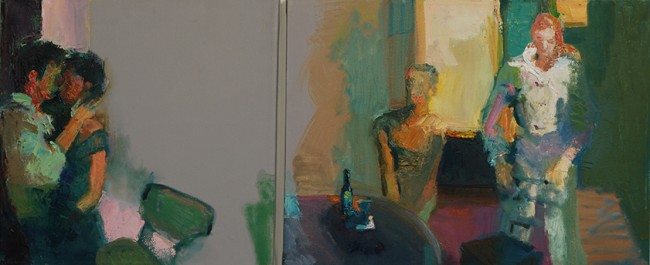by Jane Durrell
Raveled – Unraveled starts off with a a linguistic challenge. In most usages “ravel” and “unravel” carry the same meaning, but for the purposes of this exhibition they are taken to be opposites. If that were always the case, MacBeth would have had no need to knit up his raveled sleeve of care, as it was already intact, but the exhibition at the Clifton Cultural Arts Center asks us to both compare and contrast differing means to a end.
We’re presented with the work of two painters, one of whom spins out her subjects in slender lines against pale backgrounds while the other gives substance to suggestion and shadow. I suppose it’s the latter (Tina Tammaro) who is raveling and the first (Michelle Heimann) unraveling, but I might have it wrong.
Rather than quibble over the title, let’s look at the exhibition. The dual presentation is the result of the artists receiving Golden Ticket awards as the “Best in Show” winners in last year’s group exhibition at the Center. Both work in oil on canvas in ways that make for interesting contrasts. Each artist is presented individually, Heimann in a large room and Tammaro nearby in the generous width of an entrance hall.
The Clifton Cultural Center started life as a public school so its physical layout isn’t necessarily hospitable to art exhibitions; satisfactory although not perfect in this case, I would say. Since the title invites comparisons, it would have been interesting to show the two sets of paintings together and perhaps interacting. The Heimann works line the walls of a very large room, totally empty of anything else including any place to sit. What if the works had been mixed up a bit, and several Tammaros shown on temporary half-walls in that empty central space? And a few Heimann pieces interspersed with the Tammaros in the entrance hall?
As it is, the first thing we notice about the Heimann paintings is that they all share the same bright, light palette. There’s a single exception, “Asian Abstraction,” in which the colors do not become dark but do become heavier, the brightness eliminated. As a general rule blue is the only color the artist allows to darken; everything else is strong and seemingly sun-lit. These are cheerful paintings, happily abstract and busy about the edges with calm centers. In her artist’s statement Heimann says “These paintings all begin with a single mark of line, which curves and twists and becomes tangled at some point. My interest lies in creating a landscape of space, color and marks which play with the idea of being raveled and eventually unraveled..”
Tammaro, on the other hand, says of her narrative-suggesting paintings “I am interested in relationships – a moment in a life. . . .In my newest work I have brought in a political and/or cultural level as I find myself considering what we are passing on to our children.” This is perhaps most poignantly presented in the triptych “Rethinking Abraham,” where she says she is “asking the viewer to consider the impact that this ancient story has on our lives today.”
Tammaro seems to think in diptychs and triptychs; I remember only one or two single canvases in her section of the show and at least one of them carries two separate images. This encourages the viewer to think through possible meanings and relationships – the what’s going on here? response that may or may not bring you to the artist’s own turn of thought. It is, of course, perfectly acceptable to take away from a work of art a response and interpretation of one’s own, whether or not it’s the same as the artist’s, but it’s also interesting to figure out where the artist is coming from.Tammaro’s use of oil paint is very different from Heimann’s generally flat surfaces. Tammaro frequently although not always likes it thick and layered. A large triptych “Sing, Sing, Sing, Through The Darkened Dream,” provides the centerpiece for her show and is one of those exceptions. It consists of three wooded landscapes hung as a unit, each in a somewhat different set of greens, blues and yellows. Like others of Tammaro’s works here, its engaging title is a line from a poem by Charles Bukowski, from his book The Days Run Away Like Wild Horses Over the Hills. The lines are chosen when the painting is complete, the artist explains in her statement, “to add an additional layer of meaning, opening the narrative even further.” This results in some extraordinarily enigmatic titles. One, “the horses more real than my father, more real than god,” had no relationship to its diptych visible to me. You might feel the same, but the lovely line itself might send you to Bukowski’s book.
Both these artists are able practitioners, applying both talent and intellect to their work. The exhibition will run through June 14. See www.cliftonculturalarts.org for more information.
Michelle Heinmann’s work is also currently on view at La Poste Eatery in Clifton and at The Carnegie in Covington.




![TT_Rethinking AbrahamMurder or Sacrifice[1]](http://aeqai.com/main/wp-content/uploads/2014/05/TT_Rethinking-AbrahamMurder-or-Sacrifice1.jpg)



